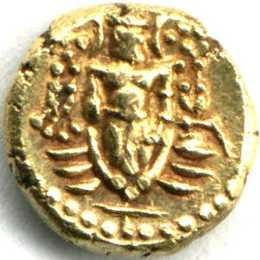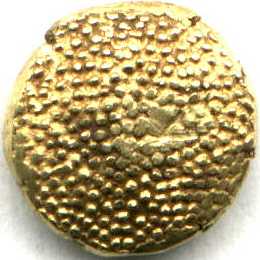| SPECIFICATIONS | |
| Denomination | One Pagoda |
| Legal | Gold Au.800 |
| Metal XRF | Gold Au0.772 |
| Alloy | Ag%Cu 0.59 |
| Type | Stuck |
| Diameter | 11.0 mm |
| Thickness | 3.4 mm |
| Weight Legal | 3.406 gms |
| Weight | 3.30 gms |
| Shape | Round |
| Edge | Plain |
| DieAxis | O° |


|

|

| ||||||||||||||||||||||||||
| Scholten 1229b KM Negapatnam #22 ; Mitchiner 1594a | ||||||||||||||||||||||||||||
Obverse : Degenerated Vishnu standing, with lazy J to right at 3 O'clock.
Reverse : Granulated.
According to Thunberg in 1777 On one side they are convex, and on the other somewhat flatter, resembling in appearance a peppermint-drop. One side has a figure upon it, and the other side, in those which are most current in the Dutch factories has only some embossed dots. i.e. Porto Novo type with granulated reverse which is slightly convex.
Three main varieties of exist of this pagoda as illustrated in Mitchiner. The gold became gradually debased with time. Au.800 (1747-1767) ; Au.769 (1767-1781) ; Au.675 (1781-1784) ; Au.625 (1788-1794). They were also struck by the English and Dutch East India Companies. From 1783-1785 the Tuticorin style Porto Novo pagoda were struck at Colombo in Lanka where they also Circulated.
According to Krause these latest issues from Tuticorin and Colombo were without the lazy J. The source of this information is unknown.
According to William Spengler in reply to a question I asked on the southasia-coins the term Lazy J used in Krause may have been lifted from the cattle culture of the American West and applied to certain symbols on coins. In designing branding irons for marking ownership of newborn calves, cattle-owners often combined letters, numbers and/or other symbols in arrangements which could not easily be confused with brands of other owners or altered by cattle-rustlers. When such a letter, number or other symbol was rendered lying on its side, it was referred to as "lazy". Thus, a letter such as "J" shown rotated 90 degrees came to be called a "Lazy J". Jan Lingen adds in his reply The so-called "lazy J" on the single swami pagodas is rotated anti-clock wise and it appears on the right side of the pagoda at the height of the hip of the diety. Jan Lingen has about 10 different Porto Novo Pagoda's, with and without the so-called "lazy J". One with a wavy line instead of J. The most degenerated type still shows the lazy J.
Text from
* Ceylon Coins and Currency By H. W. Codrington. Colombo 1924
Page 172 Chapter XIII Miscellaneous: VI - Pagodas and Fanams.
The coin was scanned at 600dpi and the images are displayed at 500dpi.
It was obtained in 2001 December from O. M. R. Sirisena an expert
collector in Colombo, Lanka. I thank Jan Lingen for detailed
reply
to a question I asked on the southasia-coins group about these Pagoda.